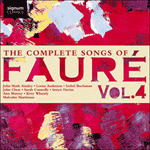The frankness and vehemence of the song betokens a mid-life crisis. Dangerous though it is to equate musical creation with biography, one feels that
Larmes strikes so unusual a note in Fauré’s song oeuvre that some such connection must exist. At the age of forty-three he seems to have been tormented about the direction of his career, the state of his finances, and a marriage in which he was not happy. The poem is from the ‘Etant de quart’ section of Richepin’s
La mer. Wilhelm Müller’s
Wasserflut (set in Schubert’s
Winterreise) uses similar imagery for tears that turn into a river. The accompaniment is jagged and peremptory and the pianist brings forth heavy teardrops in accented crotchets that are sustained under the hands while quaver rests punctuate other layers of the accompaniment. This ingenious deployment of fingers provides an unusual texture where the piano sound is both snatched away and insistent, like a stifled sob. At ‘Moi, mon existence dépensée En vœux trahis’ we are reminded of the interaction between voice and piano in
Chanson du pêcheur. The pathos of ‘Une larme tombe’ followed two beats later by ‘puis une autre’ is that of a great French
tragédien pausing between phrases for effect. Yet the vocal line is a thing of shreds and patches, it never settles into a satisfying cantilena (appropriately enough), although it achieves a bitter heroism at the close. A slew of enharmonic progressions makes flats and sharps compete for the same harmonic space; the song’s complex orthography mirrors the emotional confusion and distress of its subject.
from notes by Graham Johnson © 2005
Le franc-parler et la véhémence de cette mélodie trahissent un passage difficile du cap de la quarantaine. Même s’il est toujours hasardeux de mettre sur le même pied création musicale et biographie,
Larmes constitue une touche tellement insolite dans les mélodies fauréennes qu’on sent bien qu’un lien de ce genre doit exister. À quarante-trois ans, Fauré semble avoir été tourmenté par l’orientation de sa carrière, l’état de ses finances et un mariage dans lequel il n’était pas heureux. Le poème est extrait de la section «Étant de quart» de
La mer de Richepin. Comme la
Wasserflut de Wilhelm Müller (mise en musique dans la
Winterreise de Schubert), il recourt à l’image des larmes se faisant rivière. L’accompagnement est haché et péremptoire, et le pianiste verse de grosses larmes grâce à des noires accentuées qui sont tenues sous les mains pendant que des demi-soupirs ponctuent les autres strates de l’accompagnement. Cet ingénieux déploiement des doigts fournit une texture inhabituelle, où la sonorité du piano est à la fois dérobée et insistante, pareille à un sanglot réprimé. À «Moi, mon existence dépensée En vœux trahis», nous nous voyons rappeler l’interaction voix/piano de la
Chanson du pêcheur. Le pathos de «Une larme tombe» et de «puis une autre», deux temps plus tard, est celui d’un grand tragédien français marquant une pause entre les phrases pour asseoir son effet. La ligne vocale, toute en lambeaux et en rapiéçages, n’adopte jamais une cantilène satisfaisant (à assez juste titre), même si, à la fin, elle atteint à un héroïsme amer. Une foule de progressions enharmoniques font que bémols et dièses se disputent le même espace harmonique; l’orthographe complexe de la mélodie reflète la confusion et la détresse émotionnelle de son sujet.
extrait des notes rédigées par Graham Johnson © 2005
Français: Hypérion


 Fauré: The Complete Songs, Vol. 4
Fauré: The Complete Songs, Vol. 4
